Case Studies
Respiratory Patients Success Stories
When the going gets tough, sometimes motivation comes in the last place we thing to look — with the patients we see every day. Respiratory Management asked patients to share their challenges and how home care equipment changed their lives. Here are their success stories.
“By using this mask, I have increased my wearing time from an average of 2 hours a night to 6.5 hours a night.” Michael Artim, patient
Michael Artim
AGE 62
DIAGNOSIS
Obstructive sleep apnea
EQUIPMENT
Circadiance’s SleepWeaver Cloth Nasal CPAP Mask and ResMed’s S8 Escape II with HumidAire 3i humidifier
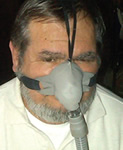
Patient Michael Artim
HIS STORY
Before his diagnosis of OSA, Michael experienced shortness of breath, vocal chord dysfunction and was tired all of the time. His wife Carole was concerned about his breathing, which was choppy and erratic, and his severe snoring. “At times the breathing seemed to stop,” Michael says. “Carole would wake me at least once a night.” In fact, his sleeping prevented Carole from getting a good night’s sleep, as well.
BIGGEST CHALLENGE
Though Michael says the process of diagnosis was much easier than expected, he did experience some issues with his equipment, primarily the mask. “I developed skin irritation to the first three masks I tried,” he says. After doing some research, he found Circadiance’s all-cloth mask and decided to give it a try. “By using this mask, I have increased my wearing time from an average of 2 hours a night to 6.5 hours a night,” Michael says. “By using the SleepWeaver mask, I am a happy user of a CPAP system rather than just another frustrated ex-patient.”
With the right equipment in place, Michael’s breathing has returned to normal. He feels more rested and awake each morning. The equipment also provided an added bonus: his wife Carole is sleeping better, too!
HOW EQUIPMENT HELPED
With the right equipment in place, Michael’s breathing has returned to normal. He feels more rested and awake each morning. The equipment also provided an added bonus: his wife Carole is sleeping better, too!
HME INSPIRATION
Unfortunately, Michael has experienced some difficulty with his HME provider and at press time had just located a new provider that really listened to his concerns. He says that providers should work to understand even the minor problems patients have when trying to use CPAP so that they don’t fall through the cracks. Michael advises providers to “take the time to tweak the system and find out what alternative equipment and measures are available for those patients that don’t fit the standard protocol.”
“This product has completely eliminated the problems Ryan had when traveling, giving us freedom to enjoy life.”
Ryan Sharkey
AGE
13
DIAGNOSIS
Obstructive sleep apnea
EQUIPMENT
Medisize’s HME-Booster, distributed by Hamilton Medical in the United States
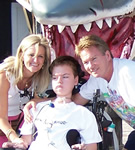
Patient Ryan Sharkey
HIS STORY
Ryan has been ventilator dependent since he was 4 months old. He has always been sensitive to humidity and had trouble using an HME (heat and moisture exchanger). Trips away from home were hard on Ryan as a result. He developed thick secretions and a blocked trach for days afterward, according to his parents, Dr. Robert Sharkey and Jackie Sharkey.
HOW EQUIPMENT HELPED
As a physician, Sharkey reads respiratory journals and he came across an ad for an HME booster in one of them. He contacted the distributor and purchased one to try with Ryan. The HME Booster, which works in conjunction with an HME, added extra humidity and heat to the vent circuit. “I was immediately impressed with how well it worked for my son, but decided to make some modifications to it to make it more portable,” Sharkey says. “The booster I purchased is actually DC-powered with an AC transformer. I removed the AC transformer and directwired the booster to the battery on my son’s chair, eliminating the need for AC power.” Initially, the family used the HME boosters for short trips away from home. Eventually, the Sharkeys decided to take a vacation to Disney, and Ryan did very well. “Before the booster, we would have to add saline to Ryan’s HME throughout the day,” Sharkey says. “Even though Ryan loved the trip, he would suffer for a week after our trip with respiratory issues. Now, we spend the entire day at the parks, with no problems whatsoever. This product has completely eliminated the problems Ryan had when traveling, giving us freedom to enjoy life.”
"Like any person with a chronic illness, I just want to live life." Amy, patient
Amy
AGE
27
DIAGNOSIS
Cystic fibrosis
EQUIPMENT
PARI ProNet Ultra II compressor, PARI Trio and RespiraTech’s Encourage Vest
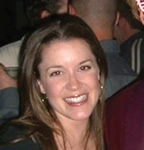
Patient Amy
HER STORY
Amy was diagnosed with CF at 6 months of age after a bout of pneumonia and the classical failure to thrive diagnosis. As she’s grown, Amy has had to learn to balance her condition around the demands of school and work. In fact, at press time, Amy had just earned her MBA with an emphasis on marketing. “Like any person with a chronic illness, I just want to live life,” Amy says. “I have this disease and it’s a big deal. I need to make sure that I take care of myself, and taking care of myself gives me the ability to go on with other aspects of my life, whether it’s studying and getting an advanced degree, or working at a company that I’m very passionate about, or having a relationship with my boyfriend, or going to football games.”
BIGGEST CHALLENGE
“Typically, cystic fibrosis patients do nebulized antibiotics, which can take anywhere from 20 to 30 minutes twice a day,” Amy says. Those treatments are in addition to other nebulized treatments and high-frequency chest compression, which can take about 30 minutes twice a day, as well. That’s a lot of time to squeeze into a day packed with school or work.
HOW EQUIPMENT HELPED
The Trio has cut down Amy’s antibiotic therapy from 20 minutes twice a day to approximately 5 minutes twice a day. “I’ve always been very compliant, but (the device) helps me to stay on that road to compliance, which ultimately means I have better lung function, which translates into a longer life.” The RespiraTech vest, which Amy got when she was 16, has helped her become independent. “When I was younger, before the vest was invented, my mom would have to lay me across her lap and cup her hands and pound my back, my thighs and my chest to loosen the thick, tenacious mucous in my lungs, which is typical of CF patients,” she says. “What that meant was that I was dependent on somebody else.”With the vest, Amy was able to go to college on her own and she’s even traveled to Europe and Asia.
HME INSPIRATION
When working with home equipment providers, Amy has had the most success with her Trio distributor, because the team took the time to turn some very technical information on the care and use of the equipment into language she could understand. In fact, education is of the utmost important to Amy and other CF patients, she says. Physicians are usually where Amy gets information, but she says they aren’t always as proactive at sharing information as she would like them to be. Amy encourages providers to use the Web site for targeted education, especially taking advantage of Webcasts and interactive Web 2.0 mediums. “I think (these things) can only enhance their brand from a business standpoint (and) also improve the patient experience,” she says. Not shy about expressing her gratitude to the industry, Amy says, “I hope those in the industry, when they go to work or they go to sleep at night, I hope they know that patients like me are incredibly grateful for the work that they do. They do make a difference. They are extending our lives and improving our quality of life.”
"Once you get used to using the CPAP, you get addicted to it." Jim Budzien, patient
Jim Budzien
AGE
58
DIAGNOSIS
Obstructive sleep apnea
EQUIPMENT
Philips Respironics’ REMstar Plus CPAP with a heated humidifier
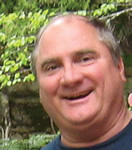
Patient Jim Budzien
HIS STORY
When Jim was first diagnosed with OSA, he wasn’t sold on the importance of treatment. In fact, he was embarrassed about using the CPAP. Jim says it took him three to four months to get used to sleeping with the CPAP. He was used to tossing and turning during the night, and he frequently tore the mask off his face because he wasn’t used to it. But then he started to notice the benefits. “I noticed I wasn’t so tired at work,” Jim says. “I didn’t have to come home and take a half-hour nap every day. … I sleep solidly all night long. I’ve got more energy and I’m not falling asleep behind the wheel of my car in the middle of the day, which I was also doing at work. Once you get used to using the CPAP, you get addicted to it. You can’t get a good night’s sleep without it.” Jim says now that he has a CPAP, he’s meeting a lot of other CPAP users. “You become like a club member with this CPAP,” he says.
BIGGEST CHALLENGE
One of the biggest challenges Jim faced when adjusting to CPAP was learning to sleep on his back. He had to teach himself to stay on his back so that the device stayed in place. In addition, the first mask Jim tried created lip irritation. A poor fit caused his lip to rub against his teeth and create a blister on the inside of his mouth. His provider switched him to a larger mask with a better fit and the problem went away.
HOW EQUIPMENT HELPED
Two major benefits Jim has noticed from CPAP is that he has more energy to do activities around the house after work and he isn’t getting as many colds as he did before. He’s also dropped a little weight because he’s more active.
HME INSPIRATION
Though Jim’s HME provider in Milwaukee explained how to use his CPAP device, he had to do a lot of learning on his own. On a recent trip to St. Petersburg, Fla., Jim talked with Mike Bishop, a respiratory therapist at BayCare, and learned about adjusting the humidifier and the air speed. Jim says he wishes providers would take more time explaining how the devices work and how to make adjustments. He says he thinks providers in Florida “have seen a lot more of the sleep apnea with the older people than up in Milwaukee.”
"The feeling was like having been held under water to your very last breath." William Taylor, patient
William Taylor
AGE
69
DIAGNOSIS
Obstructive sleep apnea
EQUIPMENT
Philips Respironics BiPAP Auto M Series and SleepNet’s IQ Nasal Mask
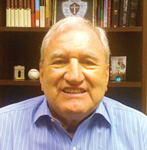
Patient William Taylor
HIS STORY
By the time William was diagnosed with OSA, he had probably had the condition for longer than 20 years. He had gone from being a high-energy person to being very lethargic. His physicians treated him for depression, anxiety and later kidney disorder because of frequent urination during the night. “The apnea condition got so bad that I found myself gasping for air,” he says. “The feeling was like having been held under water to your very last breath.” That description ultimately led to William’s diagnosis. His physician read a memo on sleep apnea and screening and William’s symptoms matched. At the sleep study, technicians determined that William was experiencing 88 episodes per hour and diagnosed him with severe sleep apnea.
BIGGEST CHALLENGE
William initially found the masks and CPAP pressures invasive and frightening. He spent a lot of time experimenting with masks before settling on a gel-type mask that is small enough to fit over his nose.William says the headgear also was important to proper fit. “If it’s not fitting properly, you don’t get the proper pressure,” he says. “It becomes noisy. It gets into your eyes. It causes your eyes to drain.” Eventually, he also switched to a bi-level device to target dryness.
HOW EQUIPMENT HELPED
“After week two or three, your life starts to change and my life changed dramatically,” he says. His kidney condition disappeared almost the moment he started treatment. He’s now sleeping 7.5 hours each night, and his other health conditions started to improve, as well. “Without the screening, without the treatment, without the diagnosis, my life would’ve been over,”William says. “I think I was about ready to have a major heart attack and stroke. It is all about the quality of life. And when you suffer the severe symptoms of severe apnea, you don’t have a life.”
HME INSPIRATION
William says counseling in the beginning to help patients overcome their fears of treatment is essential. He compares CPAPs to MRIs in the early days. People were scared to go into the tubes. So, the industry had to figure out what fears people had, and then design more user friendly equipment. The industry also had to do a better job of explaining the benefits and the consequences of forgoing the test. “I think that’s an area where certainly the industry has a great opportunity,”William says. “I think that there are significant opportunities for the health care industry itself to do a better job of informing the population and the demographic who may well be victims of this disorder. Those can be much stronger messages, I think.”
"It was like comparing a cell phone now to one of those big, monster ’80s cell phones."
Will
AGE
11
DIAGNOSIS
Cystic fibrosis
EQUIPMENT
PARI’s ProNeb Ultra II, the PARI Trek and a vest
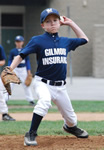
Patient Will playing baseball
HIS STORY
Although Will did not exhibit respiratory symptoms when he was diagnosed at 5 months of age, he did have failure to thrive. Between ages 2 and 4 months,Will gained only 4 ounces. Physicians knew something was wrong and encouraged Will’s mother Elizabeth to feed him more often, even though she says he ate all of the time. Will’s respiratory symptoms have remained remarkably mild, which Elizabeth contributes to the physicians’ proactive approach of starting nebulizers and the vest early.
BIGGEST CHALLENGE
Will’s biggest challenge was the length of time it took to get a diagnosis. The physicians refused to test until the family uncovered a cousin who had died of CF. In terms of equipment, Elizabeth often fights with her health insurance, which insists that she uses home medical suppliers that do not carry the PARI products. Because Will uses Tobi medications, treatment times time nearly 45 minutes twice a day.With other brands, “it was taking twice as long for him to do his treatments,” Elizabeth says. “And then also (the other compressors) give out very quickly because they’re not used to being used for that extensive period of time.”
HOW EQUIPMENT HELPED
The PARI Trek made a huge difference in Will’s life. Prior portable nebulizers were bulky and heavy. “It was like comparing a cell phone now to one of those big, monster ’80s cell phones,” Elizabeth says.With the Trek,Will is able to do his Tobi treatments in the car on the way to errands, which gives him time to play with friends. “We travel a fair amount and (the Trek) enables us to travel much more easily,” Elizabeth says. “We can pack the vest, the Trek and his meds into one carry-on suitcase. Whereas, a few years back, we had to have a big bag for the vest because the vest was bigger too and another bag for the nebulizer… It’s really made it a lot easier.”
HME INSPIRATION
Overall, Elizabeth says her experience with her home medical equipment supplier has been positive. The staff has been helpful in explaining how to use equipment, though she is a pro at it now. “They’ve been very helpful in bringing us lifesaving equipment for my son,” she says. “We’ve been very lucky that he’s had all of that stuff so it’s kept him healthy. He meets people and they have no clue he has CF.We don’t hide it; it’s just that he’s that healthy.” Elizabeth has this advice for providers to make patients’ lives easier: Get the billing right. “One little typo can cause me hours of frustration in terms of dealing with the insurance,” she says.
This article originally appeared in the Respiratory Management July/August 2009 issue of HME Business.